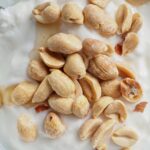Two in three children who wore the skin patch were less sensitive to peanuts after 12 months of daily use.
Toddlers with peanut allergy who wore a skin patch for 12 months had better tolerance of peanut protein, according to an Australian and international study.
The phase three, double-blind, randomised, placebo-controlled trial of 360 toddlers aged 1-3 with confirmed peanut allergy found that those who received the epicutaneous immunotherapy had better tolerance of peanut protein after one year compared to the children who wore a placebo patch.
“The children enrolled in the trial had more severe peanut allergy, meaning they reacted to one peanut or less,” said study author Associate Professor Kirsten Perrett, a consultant allergist and vaccinologist at the Royal Children’s Hospital in Melbourne.
The toddlers wore a patch – which included 250µg of peanut protein (equal to 1/1000th of one peanut) for the intervention group — between their shoulder blades every day for one year.
Two in three children given the peanut patch could tolerate higher doses of peanut protein by the end of the trial, compared with one in three in the placebo group.
Success was defined in two ways. The first was in children who initially had allergic symptoms when exposed to between 10mg and 300mg of peanut protein, but were able to tolerate 1000mg – equal to three or four peanuts – at the end of the treatment.
The other success group included those who had symptoms at 10mg of peanut protein or less initially but were able to tolerate at least 300mg at the end of the study.
Professor Perrett said that reduction in sensitivity was enough to decrease the likelihood of those children experiencing an allergic reaction after accidental peanut exposure.
The results are good news for families of young children living with peanut allergies because there are currently no approved treatment options, said Professor Perrett, who is also the director of the National Allergy Centre of Excellence and Centre for Food and Allergy Research.
“Management of food allergies relies on strict avoidance of allergens and knowing how to respond to accidental exposures and allergic reactions should they occur.”
Allergist, immunologist and immunopathologist at Royal Children’s Hospital in Melbourne, Dr Mimi Tang, said the peanut patch desensitisation therapy protected against small amounts of the allergen and accidental exposure.
However, it would not protect patients against large amounts of peanut protein, said Professor Tang, director of the Allergy Translation Centre at Murdoch Children’s Research Institute.
“They’ve shown that you can increase a child’s threshold from one peanut up to four peanuts, and that’s great,” she said.
“That gives the patient protection against accidental exposure to small amounts of peanut that might be present in packaged foods or cross contamination at a buffet bar.
“What it doesn’t protect the child against is accidental intake of something where say the food is an ingredient.”
Professor Tang said patients would still have to avoid all other sources of peanuts.
“Much of the downside of living with peanut allergy is the fact that you have all these lifestyle restrictions, social and dietary limitations as a result of having to avoid peanut. Well, that doesn’t get taken away. And that is a reason that there’s not a lot of convincing evidence that being desensitised leads to improved quality of life.”
Professor Tang said patients would also need to remain on the desensitisation therapy indefinitely because the effects were only temporary.
“It is a definite step forward in that it does provide protection against smaller amounts. However, the better endpoint that we should be striving towards is remission where you are able to stop treatment.”
The researchers said treatment adherence was high, and children wore the patch for an average of 22 hours each day.
Adverse events were observed in 100% of children in the intervention group and 99% in the placebo group, they wrote in the NEJM. Most common adverse events were local application site reactions, which decreased in frequency and severity over time, said Professor Perrett.
“Serious adverse events (excluding those that occurred during food challenges) were reported in 21 patients in the intervention group (8.6%) and in three in the placebo group,” the authors wrote.
Anaphylaxis was reported in 7% of patients in the intervention group and 3% of those in the placebo group.
“Low rates of treatment-related anaphylaxis and epinephrine use were observed,” said Professor Perrett.
The patch, called the Viaskin Peanut EPIT patch, had previously been shown to be safe and effective in children aged four to 11, but this was the first trial of the patch in children aged one to three.
Professor Perrett said the peanut patch worked by desensitising the immune system to peanut protein and reduced the underlying allergy.
The Viaskin Peanut EPIT patch is still under clinical investigation and has not yet been approved by the TGA, FDA or other regulatory agencies, Professor Perrett said.
The EPITOPE trial was funded by DBV Technologies.
In an accompanying editorial in the NEJM, US immunologist Dr Alkis Togias noted that peanut allergy can be very substantially reduced if peanut is introduced into the diet as early as 4-6 months of age.
“Early dietary introduction to prevent peanut allergy in children is now part of practice guidelines around the world, but the implementation is lagging,” said Dr Togias, from the National Institute of Allergy and Infectious Diseases.
But Dr Togias said there were questions regarding the effectiveness of early dietary introduction of peanut in real life.
“This uncertainty is to some extent due to the lack of knowledge regarding the appropriate range of the peanut-protein dose, the age at introduction, and the frequency and duration of peanut consumption needed to induce long-term tolerance.
“Even after the appropriate prevention approaches are applied, the eradication of peanut allergy is unlikely, and the need for effective treatments will remain.
“Toddlers are of particular interest since their immune systems have plasticity that can theoretically allow for higher efficacy and longer-lasting benefits from allergen immunotherapy after therapy is discontinued.”
Dr Togias noted that many patients have multiple food allergies.
“Successful studies of multifood oral immunotherapy have been conducted, so the development of multifood skin patches may also be possible.”





